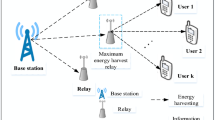Abstract
Designing a fair and efficient rate allocation scheme to maximize network performance is a challenging issue for deep space networks. Transmission rate not only affects link signal quality, but also affects network performance. In this study, a novel rate allocation framework based on differential game to settle rate allocation problems among different sources in deep space networks is proposed, and rate allocation criteria based on feedback Nash equilibrium solution is formulated. Theoretical analysis and numerical simulation demonstrate our proposed optimal rate allocation scheme can be used to maximize network performance.
Similar content being viewed by others
References
Zhou, X., Zhang, L., Cheng, Z., He, H., Wang, J., & Chen, Y. (2010). Hypernetwork model and architecture for deep space information networks. In Proceedings of IEEE ICFIT 2010, Changsha, China (pp. 8309–8317).
Akyildiz I. F., Akan O. B., Chen C., Fang J., Su W. (2003) InterPlaNetary Internet: State-of-the-art and research challenges. Computer Networks 43: 75–112
Durst R. C., Miller G. J., Travis E. J. (1997) TCP extensions for space communications. Wireless Networks 3(5): 389–403
Sekhar, A., Manoj, B. S., & Murthy Siva Ram, C. (2004). MARVIN: Movement-aware routing over Interplanetary networks. In IEEE SECON 2004. 2004 First annual IEEE communications society conference on sensor and ad hoc communications and networks (pp. 245–254).
Isaacs R. (1965) Differential games. Wiley, New York
Bellman R. (1957) Dynamic programming. Princeton University Press, Princeton
Nash J.F. (1951) Non-cooperative games. Annals of mathematics 54: 286–295
Wang, X. B., Zhou, X. W., & Song, J. D. (2011). Transmission power control and routing strategy based on differential games in deep space exploration. Wireless Personal Communications. doi:10.1007/s11277-011-0417-1.
Altman E., Basar T. (1998) Multiuser rate-based flow control. IEEE Transactions on communications 46(7): 940–949
Basar T., Zhu Q. (2011) Prices of anarchy, information, and cooperation in differential games. Dynamic Games and Applications 1: 50–73
Miao X. N., Zhou X. W., Wu H. Y. (2010a) A cooperative differential game model based on network throughput and energy efficiency in wireless networks. Optimization Letters 38: 292–295
Miao X. N., Zhou X. W., Wu H. Y. (2010b) A cooperative differential game model based on transmission rate in wireless networks. Operations Research Letters 38: 292–295
Zhang, L., Zhou, X. W., & Guo, J. W. (2012). Noncooperative dynamic routing with bandwidth constraint in intermittently connected deep space information networks under scheduled contacts. Wireless Personal Communications. doi:10.1007/s11277-012-0507-8.
Fang J., Akyildiz I. F. (2007) RCP-Planet: A rate control protocol for InterPlaNetary Internet. International Journal of Satellite Communications and Networking 25(2): 167–194
Fang J., Akan O. B. (2004) Performance of multimedia rate control protocols in InterPlaNetary Internet. IEEE Communications Letters 6(11): 478–480
Grieco L.A., Mascolo S. (2005) A congestion control algorithm for the deep space Internet. Space Communications 20: 155–160
Gardikis G., Kourtis A. (2007) A cross-layer rate control mechanism for link-adaptive satellite integrated services. Research Letters in Communications 2007: 1–4
Alagoz F., Walters D. (2001) Adaptive rate control and QoS provisioning in direct broadcast satellite networks. Wireless Networks 7(3): 269–281
Castro, M. A. V., Han, Z., Hjorungnes, A., & Marina, N. (2009). Rate allocation for satellite systems with correlated channels based on a Stackelberg game. In International conference on game theory for networks (pp. 638–645).
Marchese M., Mongelli M. (2007) Adaptive rate allocation and resource planning for service level agreement maintenance in satellite communications. Computer Communications 2007(30): 3179–3192
Yeung D. W. K. (2007) Dynamically consistent cooperative solution in a differential game of transboundary industrial pollution. Journal of optimization theory and applications 134(1): 143–160
Kuniyur S., Srikant R. (2003) End-to-end congestion control schemes: Utility functions, random losses and ECN marks. IEEE/ACM Transactions on Networking 10(5): 689–702
Yeung D. W. K., Petrosyan L. A. (2005) Cooperative stochastic differential games. Springer, New York
Author information
Authors and Affiliations
Corresponding author
Rights and permissions
About this article
Cite this article
Cheng, Zm., Zhou, Xw. & Ding, Y. A Transmission Rate Control Algorithm Based on Non-cooperative Differential Game Model in Deep Space Networks. Wireless Pers Commun 71, 1915–1929 (2013). https://doi.org/10.1007/s11277-012-0915-9
Published:
Issue Date:
DOI: https://doi.org/10.1007/s11277-012-0915-9




